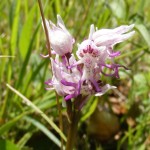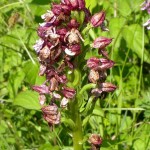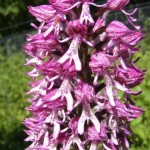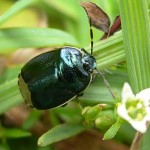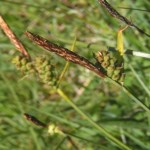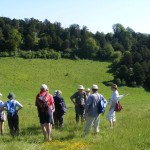Chris Raper and Malcolm Storey led a field trip to BBOWT’s Hartslock reserve near Goring on Saturday 26th May. It was a hot and sunny afternoon with a strong easterly wind. The Monkey Orchids were in full flower. There were 2 Lady Orchids in flower and they were a little past their best. They were first recorded on the reserve in about 1997 and DNA analysis shows that they probably originated from Provence. The hybrid offspring of the Monkey and Lady Orchids, which first appeared in 2002, are going from strength to strength. They are considerably taller than either of their parents and share characters from both. So far, they have been well behaved, keeping out of the main Monkey Orchid area and moving instead towards woods – one has already appeared on the outside side of the fence. While Chris recounted the history of the hybrids, a Green Hairstreak butterfly fluttered about in the tree behind his head.
Another speciality of the reserve is the Downy-fruited Sedge, which grows in a small patch near the bottom of the slope. Members of the group took it in turn to lie down and inspect the fruits with a hand-lens. Returning to the top of the hill, there was welcome shade in the wood, where a few White Helleborines were in flower. A number of butterflies were flying on the hillside, including Dingy Skipper, Small Heath, Common Blue and more Green Hairstreaks. Brimstones and Orange-tips were patrolling along the edge of the woods and a single new generation Small Tortoiseshell was seen. Moving further into the reserve, the Horseshoe Vetch appeared to be doing particularly well. Pasqueflowers had been introduced a few years ago. They had been planted in a regular grid, which made them easy to find, and one was still in flower. Semi-parasitic Bastard-toadflax was growing amongst the sward and a single specimen of the metallic blue Bastard-toadflax Bug, or Down Shieldbug, Canthophorus impressus was captured for closer inspection. A Hobby was watched as it flew over the woods and the fields next to the Thames.
The fields at the top end of the valley are now being managed by BBOWT. Chris explained that there had just been a sea of long grass when the Trust first took them over, but after a few seasons of hard grazing, the structure, with its many anthills, has reappeared. From the far side of the field, Graham Saunders heard an animal calling and spotted a fox just inside the wood, carrying a rabbit in its mouth. Initially the fox was being followed by a single cub, then 2 more cubs appeared. They were about ¾ size of their parent and quite active. The rabbit was calling in distress. The cubs lay on the ground with paws forward and heads up, intently watching the action as the rabbit was subdued. Although Graham was only about 10 metres away, none of the foxes saw him.
EDIT (14/11/2012): Matthew Oates visited the site this year for BBC Radio4’s series “In Pursuit of the Ridiculous“. If you would like to listen to the program it can be found on iPlayer here: http://www.bbc.co.uk/programmes/b01ntg59
Pictures by Rob Stallard, Chris Raper and Jan Haseler
RDNHS excursion to Hartslock, 26-5-2012
List by Renee Grayer
Plant species observed:
| Bellis perennis | Daisy |
| Blackstonia perfoliata | Yellow-wort |
| Briza media | Quaking-grass |
| Bromus erectus | Upright Brome |
| Bryonia dioica | White Bryony |
| Campanula glomerata | Clustered Bellflower |
| Carex filiformis | Downy-fruited Sedge |
| Carex flacca | Glaucous Sedge |
| Carlina vugaris | Carline Thistle (last year’s fruits) |
| Cephalanthera damasonium | White Helleborine |
| Cirsium acaule | Dwarf Thistle |
| Clematis vitalba | Traveller’s-joy |
| Cornus sanguinea | Dogwood |
| Crataegus monogyna | Hawthorn |
| Dactylorhiza fuchsii | Common Spotted-orchid |
| Glechoma hederacea | Ground-ivy |
| Helianthemum nummularium | Common Rockrose |
| Hippocrepis comosa | Horseshoe Vetch |
| Hypericum hirsutum | Hairy St John’s-wort |
| Ligustrum vulgare | Wild Privet |
| Linum catharticum | Fairy Flax |
| Listera ovata | Common Twayblade |
| Lithospermum officinale | Common Gromwell |
| Lotus corniculatus | Common Bird’s-foot Trefoil |
| Mercurialis perennis | Dog’s mercury |
| Orchis purpurea | Lady Orchid |
| Orchis simia | Monkey Orchid |
| Orchis simia x O. purpurea | Hybrid between Monkey and Lady Orchid |
| Origanum vulgare | Marjoram (leaves) |
| Plantago lanceolata | Ribwort Plantain |
| Polygala calcarea | Chalk Milkwort |
| Polygala vulgaris | Common Milkwort |
| Primula veris | Cowslip |
| Pulsatilla vulgaris | Pasqueflower (planted) |
| Ranunculus acris | Meadow Buttercup |
| Ranunculus bulbosus | Bulbous Buttercup |
| Rhinanthus minor | Yellow-rattle |
| Sanguisorba minor | Salad Burnet |
| Tamus communis | Black Bryony |
| Thesium humifusum | Bastard Toadflax (in bud) |
| Thymus polytrichus | Wild Thyme |
| Trifolium pratense | Red Clover |
| Veronica chamaedrys | Germander Speedwell |
| Veronica officinalis | Heath Speedwell |
| Viburnum lantana | Wayfairing-tree |
| Viola hirta | Hairy Violet |
Butterflies and other insects:
| Aglais urticae | Small Tortoiseshell |
| Anthocharis cardamines | Orange-tip |
| Callophrys rubi | Green Hairstreak |
| Celastrina argiolus | Holly Blue |
| Polyommatus icarus | Common Blue |
| Erynnis tages | Dingy Skipper |
| Gonepteryx rhamni | Brimstone |
| Coenonympha pamphilus | Small Heath |
| Canthophorus impressus | Bastard Toadflax Bug |
Birds:
| Cuculus canorus | Cuckoo |
| Falco subbuteo | Hobby |
| Phylloscopus collybita | Chiffchaff |
| Turdus philomenos | Song Thrush |

